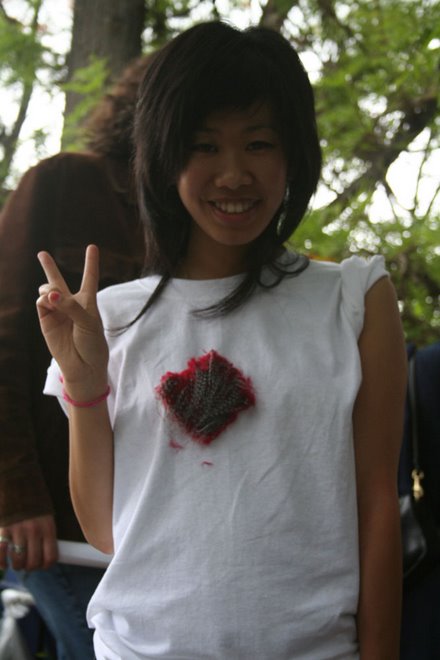
On “Exchange/Alteration”:

After a trial run in Nomart mobile art space in San Diego for the weeklong show Fantastic Domestic, Mélanie Badalato and Camilo Ontiveros brought “Exchange/Alteration” to Tijuana. The project was conceived in response to the tri-city show, Where:, organized by Amy Adler, Shannon Spanhake and Zerek Kempf. The show began at the Lui Velazquez space in Tijuana, B.C. Badalato and Ontiveros made a call to the participants of the first part of the tri-city show to donate clothes to be used in the next city, Los Angeles. “Exchange/Alteration” was their way to connect the three cities through a consistent fabric that would map the progression of the show.

In the garden of the Sundown Salon, Badalato and Ontiveros set up their sewing station and makeshift changing room. The sewing duo lent the participants pre-altered clothes to wear while they altered their shirts, pants, skirts, jackets with the fabric collected in Tijuana and San Diego. Throughout the 6-hour event, more and more people were seen walking around the geodesic dome and garden wearing their brightly altered clothing.



That summer, the show moved to the Queen’s Nails Annex in San Francisco. There, Badalato and Ontiveros combined leftover pieces of fabric from Tijuana and Los Angeles to dress the façade of the gallery. On the inside of the gallery, they mapped the previous performance by stitching together photo documentation.

Badalato and Ontiveros met Irene Tsatos at the Sundown Salon, who invited them to be a part of “Fair Exchange,” a show that exhibited artists and activists who use traditional crafts as tools for social interaction and change at the Fairplex & Millard Sheets Gallery, in Los Angeles.


They were interested in infiltrating the fair vendors in order to reach some participants who may not otherwise encounter the exhibit. After altering a handful of adventurous fair-goers clothes, Badalato and Ontiveros were forced to leave the vendor’s area, since they did not have a permit, and were in fact, not selling anything.


For the performance inside the gallery, they continued to alter the participants’ clothes on the spot and presented a slideshow of past performances, so that they could see the network of people that was growing through the exchange and alteration of their clothes.
For the closing night of the fair and “Fair Exchange” they lined up members of the Badalato & Ontiveros families to exchange/alter their shirts, in increasing size, from baby to grandpa. The result was a mix of families through their shirts and a microcosm of what was happening with their performances between Tijuana and San Francisco. Afterward, they continued to alter other families and fair-goers’ and “Fair Exchangers’” clothes.

“Exchange/Alteration” concluded at the CECUT, in Tijuana. Mélanie Badalato and Camilo Ontiveros returned to Tijuana for the festival Entijuanarte to wrap up the traveling project. They used up the last of the donations received six months prior at Lui Velazquez to perform one last series of alterations and present the cycle in its completion.


After the last stretch of the initial cycle of “Exchange/Alteration” at the CECUT, Ontiveros and Badalato received an invitation to lead an alteration workshop at the newly expanded Museum of Contemporary Art in downtown San Diego. Large crowds flock to the museum’s monthly art event ‘TNT,’ the first Thursday of every month, to enjoy artists’ talks, new exhibits and live music. On February 1st, the downtown MOCA hosted the “Best of TNT” event in celebration of the inaugural TNT in the new extension of the museum. Ontiveros and Badalato set up their sewing station next to Perry Vasquez’ Fotoaktion stage. The new workshop consisted of Badalato and Ontiveros in addition to fellow artist friends, including Angela Tsai, Grace Smith, and Teresa Trout.

The large patchwork piece that once covered the Queen’s Nails Annex façade in San Francisco now covered the worktables in SD MOCA. After seven manifestations of the project in Tijuana, Los Angeles and San Francisco, the duo was happy to perform in the city that served as their home base for the majority of their collaborative work and honored for this next rendition to be at their favorite monthly art event. This performance differed from the previous seven in that the network created was not connected to the three other cities through the fabric used. Since the pieces collected in Tijuana were all used up to complete the first cycle of “exchange/alteration,” the performance at TNT would be an autonomous piece. This time, the sewing team would cut a large hole out of the back of the shirts of the participants, save half of that piece for a future project, and sew the other half on the front of the next person in line’s shirt.


Ontiveros and Badalato provided pre-altered shirts for the participants to change into during the course of the alteration if they were not prepared. The three-hour performance created a chain through the taking, splitting and giving of dozens of TNT goers’ shirts. The taking was punctuated by the gaping holes in the backs of their shirts. The splitting was evident of the growing pile of little pieces that diminutively represented the network of altered participants. The giving was apparent in the badge-like patches that adorned the front of every shirt. The price of each piece was dependent on the symbolic value of each exchange and free meaningless-without-metaphor alteration.

If you are interested in “Exchange/Alteration,” feel free to contact the artists:
Camilo Ontiveros at zeusguerra@gmail.com
Melanie Badalato at melmabelle@gmail.com
